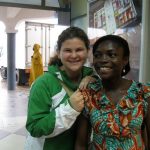As Kofi lead us to the school, I was keenly inquiring about the students and the subjects taught to them. The school had started in 1970s when Kofi himself was a student there. After his father passed away, he took over the reins and now serves as the headmaster.
Soon we entered the white plastered building and went inside a big classroom where all the students had gathered. As we entered and settled in our chairs on the stage, they broke into a loud applause as a welcoming gesture.
Running my eyes around the room made me wonder about how the physical make-up of a place speaks volumes about the history, culture, socio-economic structure, implicit and explicit power hierarchies. For instance, our chairs had been put on an elevated stage where all 15 of us sat comfortably whereas in front of us, the school students huddled together and very well surpassed the benches’ maximum capacity. Additionally, the Welcome cultural program was performed facing us and in the back of the room, the students could be seen raising their heads in anticipation and curiosity since they were not able to see the faces of the performers.
Though the students put together a fantastic show, some of the observations of the set-up and structure of the room pointed towards an implicit power hierarchy between ‘us’ and ‘them’ that put us in a privileged position. It is certainly intriguing to contemplate the various reasons of our privilege and where they eventually stem from.
Also, it is important to be conscious about the implications of the physical design of a place but shouldn’t that consciousness lead to some action?
I was intensely aware of the position we were placed in but what did I do about it?
Nothing.
What could have I done?
I don’t know.



Comments by jaclynr